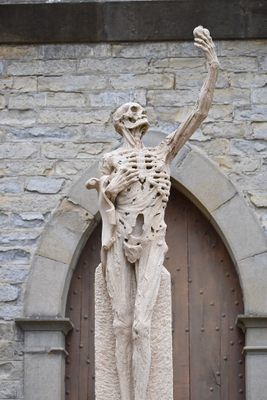About
On the outskirts of the town of Moux can be found a curious mausoleum outside of which stands an unnerving sculpture of a grinning cadaver in a state of advanced decomposition, which holds a human heart aloft in one of its skeletal hands.
This curious and macabre tomb is the last resting place of the famous 19th and early 20th-century poet and playwright Félix-Henri "Henry" Bataille. His work often featured recurring themes such as the power of indomitable passion and the suffocating, often hypocritical, social mores and conventions that crushed the human spirit and individuality.
The popularity of Bataille's poetry and plays reached their zenith in the decade between the turn of the 20th century and the outbreak of World War I. Several of his plays were adapted into scripts for Broadway productions and early silent films in the United States. Despite having achieved a great deal of success and recognition in the arts, Bataille died in 1922, at the relatively young age of 49.
Before he died, Bataille had given precise instructions for the construction of this tomb, which was to be a homage of sorts to the Renaissance. The tomb was to include reproductions of his favorite monuments from this period such as the marble fountain of Beaune at Tours and the cadaver statue of Ligier Richer from the sepulcher of René de Chalons in Bar le Duc. (Unlike the sculpture that inspired it, the skeletal figure on Bataille's tomb does not contain his actual heart.)
Per his instructions, the cadaver sculpture was to be displayed prominently to the visitor to the tomb: "On top of this I want the statue of Ligier Richer to be placed, one of the most beautiful works of French genius, which expresses all the spirituality of death, all the beauty of human effort."
Related Tags
Know Before You Go
The tomb can be seen for free outside of the town of Moux though the location is a bit out of the way and so is a bit of a hike to get to.
Community Contributors
Added By
Published
October 28, 2021











































